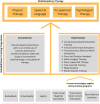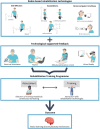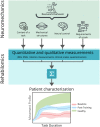Neuromechanical Biomarkers for Robotic Neurorehabilitation
- PMID: 34776920
- PMCID: PMC8579108
- DOI: 10.3389/fnbot.2021.742163
Neuromechanical Biomarkers for Robotic Neurorehabilitation
Abstract
One of the current challenges for translational rehabilitation research is to develop the strategies to deliver accurate evaluation, prediction, patient selection, and decision-making in the clinical practice. In this regard, the robot-assisted interventions have gained popularity as they can provide the objective and quantifiable assessment of the motor performance by taking the kinematics parameters into the account. Neurophysiological parameters have also been proposed for this purpose due to the novel advances in the non-invasive signal processing techniques. In addition, other parameters linked to the motor learning and brain plasticity occurring during the rehabilitation have been explored, looking for a more holistic rehabilitation approach. However, the majority of the research done in this area is still exploratory. These parameters have shown the capability to become the "biomarkers" that are defined as the quantifiable indicators of the physiological/pathological processes and the responses to the therapeutical interventions. In this view, they could be finally used for enhancing the robot-assisted treatments. While the research on the biomarkers has been growing in the last years, there is a current need for a better comprehension and quantification of the neuromechanical processes involved in the rehabilitation. In particular, there is a lack of operationalization of the potential neuromechanical biomarkers into the clinical algorithms. In this scenario, a new framework called the "Rehabilomics" has been proposed to account for the rehabilitation research that exploits the biomarkers in its design. This study provides an overview of the state-of-the-art of the biomarkers related to the robotic neurorehabilitation, focusing on the translational studies, and underlying the need to create the comprehensive approaches that have the potential to take the research on the biomarkers into the clinical practice. We then summarize some promising biomarkers that are being under investigation in the current literature and provide some examples of their current and/or potential applications in the neurorehabilitation. Finally, we outline the main challenges and future directions in the field, briefly discussing their potential evolution and prospective.
Keywords: EEG; EMG; exoskeleton; kinematic measurement; motor control; robotic rehabilitation; stroke; upper limb rehabilitation.
Copyright © 2021 Garro, Chiappalone, Buccelli, De Michieli and Semprini.
Conflict of interest statement
The authors declare that the research was conducted in the absence of any commercial or financial relationships that could be construed as a potential conflict of interest.
Figures







References
-
- Abdallah I. B., Bouteraa Y., Rekik C. (2017). Design and development of 3D printed myoelectric robotic exoskeleton for hand rehabilitation. Int. J. Smart Sens. Intelligent Syst. 10, 341–366. 10.21307/ijssis-2017-215 - DOI
-
- Akeret K., Vasella F., Zindel-Geisseler O., Dannecker N., Brugger P., Regli L., et al. . (2020). Passive smartphone-based assessment of cognitive changes in neurosurgery. MedRxiv [Preprint]. 10.1101/2020.11.10.20228734 - DOI
Publication types
LinkOut - more resources
Full Text Sources

